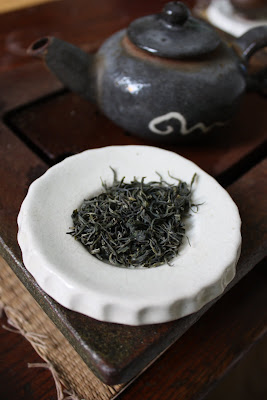
A friend in Korea commented that the first flush of Ujeon grade tea is a bit behind schedule this year due to an unusually cool spring. Traditionally Ujeon grade (the first flush in Korea based on the 24 seasonal divisional Asian calendar) is harvested on or before April 20th or 21st. The last few years in Korea have seen this harvest pushed up earlier and earlier in the month- this year will be closer to the actual traditional dates. Unlike the shincha production in Japan this year, the cool weather hasn't seemed to cause any damage- just a delay in production. Good news.
The green that fill today's cup is an offering from Dao tea. This is one of two Korean greens that one has been sipping the last few weeks. Again, both are from Dao Tea and both are from the same producers as the yellow teas reviewed last month. This one was made by Teamaster Kim Kim Jong Yeol.

The dry leaves smell musty and deep- nutty chocolate can be glimpsed at amongst the depth. When the leaves are revealed they are quite small for a Saejak, and exhibit a turquoise hue to them. When the water temperature dictates, the session begins.
The first infusion is light with slight, sweet floral notes. It ends nutty in the mouth with suggestions of a roasted taste to come.
In the second infusion comes that roasted flavour which somewhat overtakes some of the subtleties of the first infusion but, with it, brings some breadth to this tea. The mouthfeel is from the lips to the throat. Light roasted tea notes ride their way out on the calm inhalations and exhalations.

The third infusion is creamy and sweet initial with a subtle twist of lime. These flavours turn chalky and full in the mouth and end with a welcomed roasted nut taste. There are some sweet and sour fruity notes that appear here (sometimes these notes are even apparent in the first infusion but to a lesser extent).
The fourth infusion is creamy and roasted with most of the sweet notes dispersed. The aftertaste is much more tart.

The fifth and sixth infusions are still roasted and deep but have much more of a floral touch to them. The sixth becomes grainy, the finish is nutty and tart.
Due to the wonderful processing of this tea, it can be easily enjoyed into the seventh infusion. Here a watery creaminess fills the throat, there is still some floral notes left. With a sip the whole mouth astringes under the influence of this tea. There are earthy and wood suggestions at the end.
The gentle chaqi softens and alerts without much fuss as one enjoys the warm spring breeze flowing through the room.
Peace


Hello Matt,
ReplyDeletejust wanted to say that I'm very impressed by the way you take photos of teas and how you arrange flowers on these photos - they always looks so simple and gentle, but natural in the same tame. It's like if I could almost feel the wonderful smell of teas you write about thanks to these pictures.
Therefore, I hope you will keep your great work and delight us with many more articles.
Always pleasure reading your blog!
Michal,
ReplyDeleteKind words, kind words.
One will be following your new tea blog. Can see you enjoy Korea green as well.
Peace
Matt,
ReplyDeleteThanks!
I indeed do. And luckily I often find myself in Czech republic, where it isn't so difficult to get some really good Korean teas... as you already know, if I remember right.
Michal,
ReplyDeleteYou must be referring to Martin Spimr's shop (http://www.teamountain.cz/).
As you know, he sells great Korea tea ;)
Peace
Matt,
ReplyDeleteyes, that's exactly what I meant. ;)
He also has some wonderful Japanese teas and Darjeeling, for example... His shop really is a treasure!
Michal,
ReplyDeleteNice chap too!
Peace